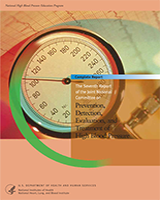NCBI Bookshelf. A service of the National Library of Medicine, National Institutes of Health.
The purpose of the Seventh Report of the Joint National Committee on Prevention, Detection, Evaluation, and Treatment of High Blood Pressure (JNC 7) is to provide an evidence-based approach to the prevention and management of hypertension. The key messages of this report are: in those older than age 50, systolic blood pressure (SBP) of >140 mmHg is a more important cardiovascular disease (CVD) risk factor than diastolic BP (DBP); beginning at 115/75 mmHg, CVD risk doubles for each increment of 20/10 mmHg; those who are normotensive at 55 years of age will have a 90 percent lifetime risk of developing hypertension; prehypertensive individuals (SBP 120–139 mmHg or DBP 80–89 mmHg) require health-promoting lifestyle modifications to prevent the progressive rise in blood pressure and CVD; for uncomplicated hypertension, thiazide diuretic should be used in drug treatment for most, either alone or combined with drugs from other classes; this report delineates specific high-risk conditions, which are compelling indications for the use of other antihypertensive drug classes (angiotensin-converting enzyme inhibitors, angiotensin-receptor blockers, beta blockers, calcium channel blockers); two or more antihypertensive medications will be required to achieve goal BP (<140/90 mmHg, or <130/80 mmHg for patients with diabetes and chronic kidney disease); for patients whose BP is >20 mmHg above the SBP goal or 10 mmHg above the DBP goal, initiation of therapy using two agents, one of which usually will be a thiazide diuretic, should be considered; regardless of therapy or care, hypertension will only be controlled if patients are motivated to stay on their treatment plan. Positive experiences, trust in the clinician, and empathy improve patient motivation and satisfaction. This report serves as a guide, and the committee continues to recognize that the responsible physician's judgment remains paramount.
Contents
- Acknowlegements
- Foreword
- Introduction
- Methods
- Lifetime Risk of Hypertension
- Blood Pressure and Cardiovascular Risk
- Basis for Reclassification of Blood Pressure
- Classification of Blood Pressure
- Importance of Systolic Blood Pressure
- Prevention of Hypertension: Public Health Challenges
- Calibration, Maintenance, and Use of Blood Pressure Devices
- Patient Evaluation
- Identifiable Causes of Hypertension
- Genetics of Hypertension
- Treatment
- Special Situations in Hypertension Management
- Drugs and Other Agents Affecting Blood Pressure
- Improving Hypertension Control
- Scheme Used for Classification of the Evidence
- References
This work was supported entirely by the National Heart, Lung, and Blood Institute. The Executive Committee, writing teams, and reviewers served as volunteers without remuneration.
- NLM CatalogRelated NLM Catalog Entries
- Seventh report of the Joint National Committee on Prevention, Detection, Evaluation, and Treatment of High Blood Pressure.[Hypertension. 2003]Seventh report of the Joint National Committee on Prevention, Detection, Evaluation, and Treatment of High Blood Pressure.Chobanian AV, Bakris GL, Black HR, Cushman WC, Green LA, Izzo JL Jr, Jones DW, Materson BJ, Oparil S, Wright JT Jr, et al. Hypertension. 2003 Dec; 42(6):1206-52. Epub 2003 Dec 1.
- The Seventh Report of the Joint National Committee on Prevention, Detection, Evaluation, and Treatment of High Blood Pressure: the JNC 7 report.[JAMA. 2003]The Seventh Report of the Joint National Committee on Prevention, Detection, Evaluation, and Treatment of High Blood Pressure: the JNC 7 report.Chobanian AV, Bakris GL, Black HR, Cushman WC, Green LA, Izzo JL Jr, Jones DW, Materson BJ, Oparil S, Wright JT Jr, et al. JAMA. 2003 May 21; 289(19):2560-72. Epub 2003 May 14.
- 2010 guidelines of the Taiwan Society of Cardiology for the management of hypertension.[J Formos Med Assoc. 2010]2010 guidelines of the Taiwan Society of Cardiology for the management of hypertension.Chiang CE, Wang TD, Li YH, Lin TH, Chien KL, Yeh HI, Shyu KG, Tsai WC, Chao TH, Hwang JJ, et al. J Formos Med Assoc. 2010 Oct; 109(10):740-73.
- Review Moderately Elevated Blood Pressure: A Systematic Review[ 2004]Review Moderately Elevated Blood Pressure: A Systematic ReviewSwedish Council on Health Technology Assessment. 2004 Oct
- Review Moderately Elevated Blood Pressure: A Systematic Review[ 2008]Review Moderately Elevated Blood Pressure: A Systematic ReviewSwedish Council on Health Technology Assessment. 2008 Sep
- The Seventh Report of the Joint National Committee on Prevention, Detection, Eva...The Seventh Report of the Joint National Committee on Prevention, Detection, Evaluation, and Treatment of High Blood Pressure
Your browsing activity is empty.
Activity recording is turned off.
See more...
